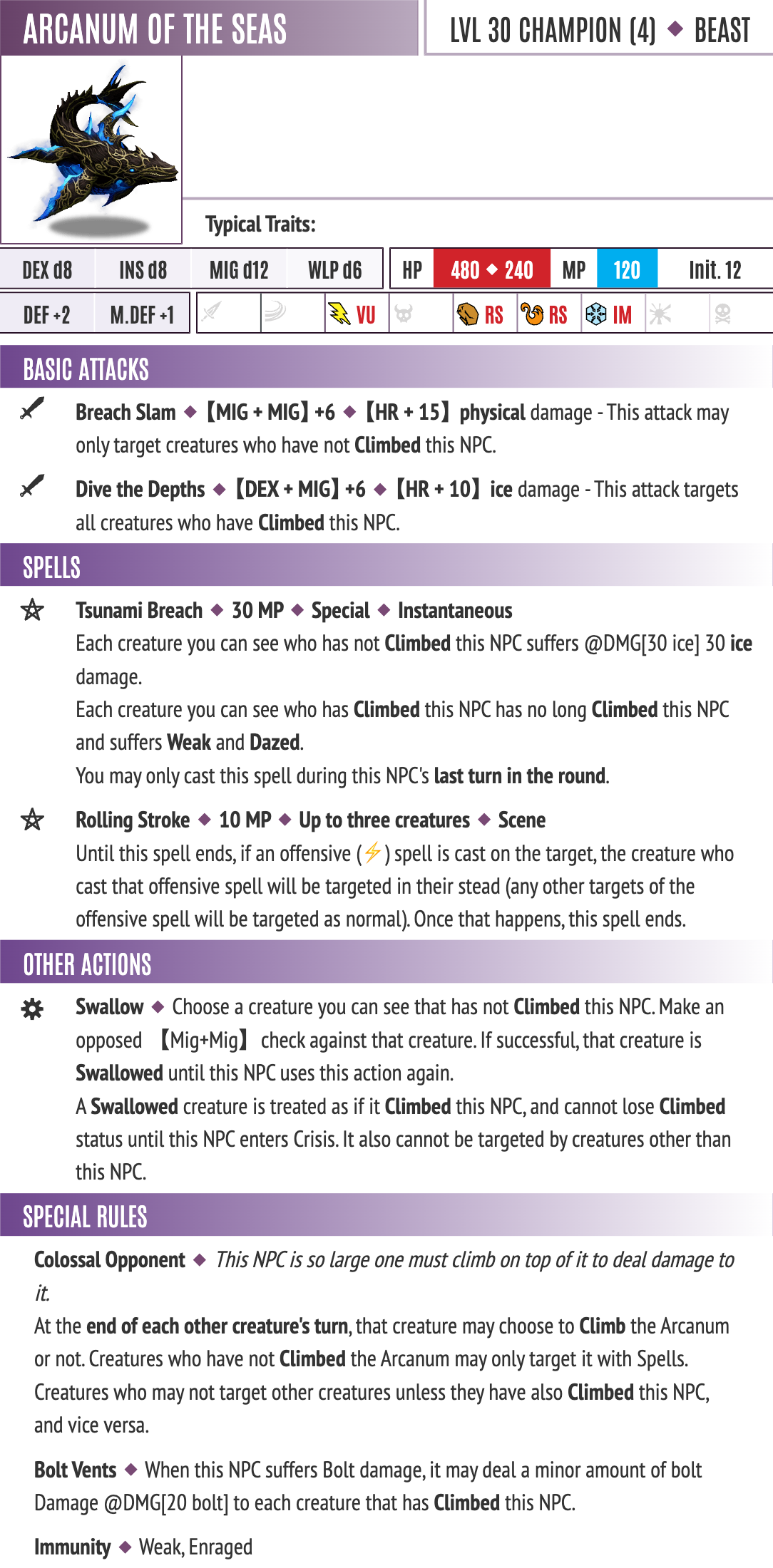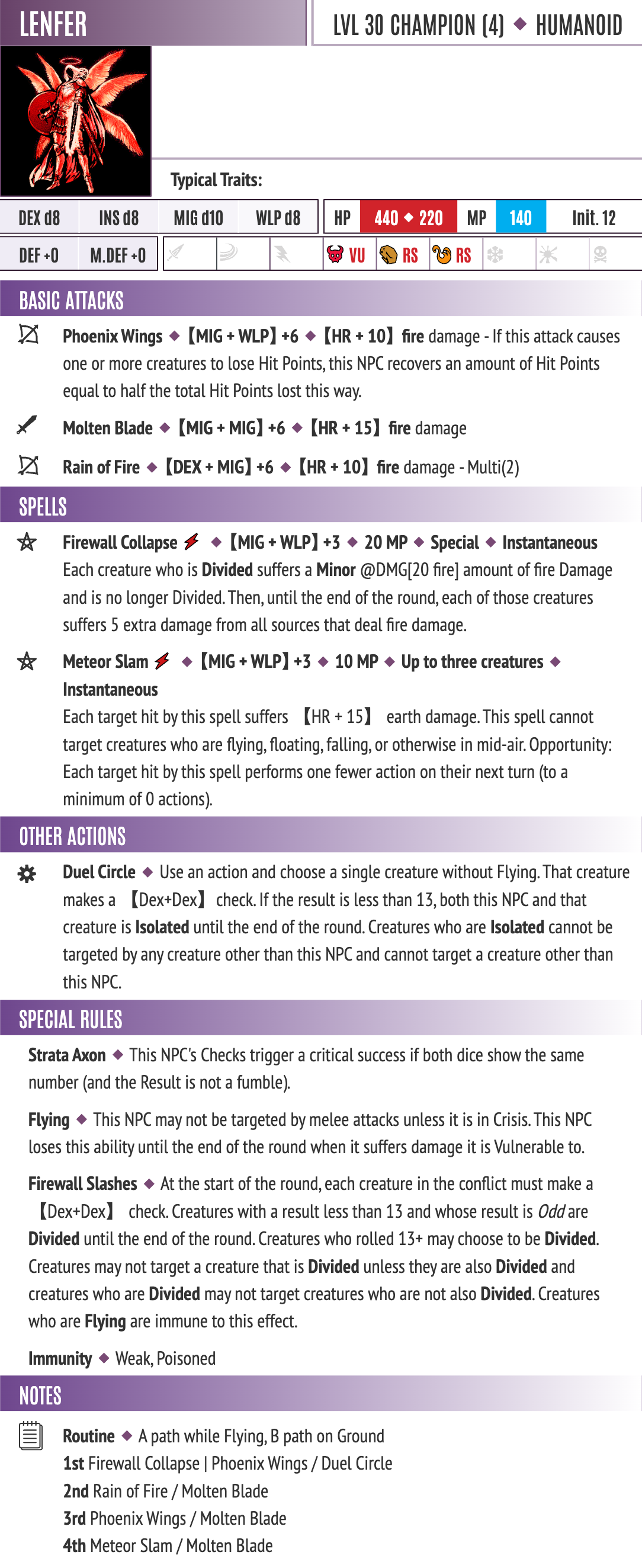Positioning in fabula ultima
Two experiments on positioning mechanics in Fabula Ultima and some theory crafting around them.
I recently had two boss encounters where I tried different attempts at making positioning part of the conflict. They had ups and downs but both parties (each encounter was for a different campaign) enjoyed the fights so I’m writing up the approaches to share for anyone else who wants to try something like that. I’ll include the stat blocks for each boss at the end of the page.
Defining the Positions
Approach 1: The Colossus
This fight was against the Arcanum of the Seas, which is a giant whale. Here there were two positions: On the Whale and Off the Whale (which in this case was a ship in the ocean, the whale was circling it in the conflict). The following additional rules applied to the conflict:
- While Off the Whale, you couldn’t target the whale with anything but Spells. This prevented the Attack action from being used even with Ranged attacks, which I described as “in order to shoot something that’s actually vulnerable to damage on the whale, you need to get onto it”.
- You could can only target allies with abilities and skills if they’re in the same position as you, so you could Cover someone On the Whale if they were also On the Whale, but not if they were Off the Whale.
- Once during a PC’s turn before or after their action, they can switch their position. We also ruled on the fly that if you Cover someone as part of the Guard action, you can move that person with you to the opposite position.
Approach 2: The Firewall
In this fight, the party was fighting a fire attributed angel which had the ability to create large walls of Flame. This fight also had two positions, Left and Right sides of the battlefield. The following base rules applied:
- While on the Left, you could only target creatures that were also on the Left and vice versa for the Right. Any creature with Flying is immune to this: it can target and be targted by creatures on either side.
- At the start of a round, each creature who isn’t Flying rolls a [Dex+Dex] check. On a 13 or higher, they can choose they side the end up on. Otherwise, creatures with an odd number go on the Left and creatures with an even go on the Right. If a creature loses Flying, it immediately has to make this same check.
- Creatures are not allowed to change their side until the next round when they roll again. (Though I did allow my group to start Objective clocks to create one use paths through the firewalls.)
Building the NPC to use Positioning
Both approaches above establish the combat space for the fight. Next, the NPC skills need to leverage positioning to make the mechanic matter. These are examples of what I did in the above encounters, to give an idea of what can be done. (These examples refer to the whale fight, but can be found in both fights.)
- An effect that targets everyone in one position. This is a strong deterrent from everyone piling into one position that’s got the best avenue of attack, such as On the Whale for an Attack focused group in my encounter.
- A counter that hits targets in a particular area. In my encounter, the whale was weak to Bolt damage, but it would vent a minor amount of that damage to anyone standing on it. This encouraged the use of Bolt damage via Spells over Elemental Weapon or other effects that modify Attack damage.
- An effect that changes based on the position you’re in when it hits. The whale performed the Devastation spell (30 damage to all targets) on creatures who were Off the Whale, but those On the Whale suffered multiple Status Effects (from being thrown off the whale) instead. Which leads into…
- Effects that force a target into a position. The above bullet mentioned one, but another option the whale had was to swallow a target, effectively forcing them to remain On the Whale until the whale entered Crisis.
Putting it Together
These are some examples, but there’s plenty more design space. The most important part in my mind are making each position have a positive and negative to it. In the angel fight, being on the opposite side of the party healer could have devastating consequences while in the whale fight everyone being able to attack the whale meant everyone was taking damage each round.
There’s some less literal positives and negatives as well. I could imagine a Colossus fight against something with multiple parts to climb up, and if you hit the top most part it’s Vulnerable to all forms of damage. Each new position comes with new dangers, but getting all the way to the top is a big reward.
The next thing to keep in mind would be how PCs are allowed to move between positions. Can they go to any other position in a single turn, or do they have a set path through them? Do they have control over how they move between positions? An enemy on a giant roulette board that changes everyone’s position round to round plays very differently than surrounding a massive beast.
Then you’ll need to keep in mind what basic actions in the conflict care about position. In mine, I put limits on the Attack action mostly. In one fight Spells were unaffected by position, in the other they were similarly limited. I could absolutely see implementing a fight where Objective actions can only be interacted with in a particular position as well.
Figure out the core actions that will be affected, then be flexible in the moment! I hadn’t thought about Guard at all in the whale fight and allowed the mechanic of moving an ally you’re covering on the spot. Run with what makes sense for your group and feels fun. I actual had a Pilot with the Flying module in the whale fight that theoretically could have avoided most of the positioning mechanics. But the player and I felt it would cheapen the fight experience for them so we agreed it made sense they had to land on the whale or ship just as much as anyone else.
Wrapping up with Examples
To help illustrate the above points, I’ll point out how some of them manifested in my two conflicts.
In the Whale fight:
- On the Whale means you can use the attack action to deal damage, but every person in this position gets hit by one of the whale’s basic attacks. You also only suffer Status Effects instead of damage from the whale’s Devastation spell.
- Off the Whale you can’t attack, but the whale can only attack one target at a time when they aren’t on him. However, Devastation will deal damage to everyone off the whale, and in this position you can be Swallowed, taking away you’re ability to get back off the whale at all.
In the Angel fight, Both Left and Right are the same while the angel has Flying. The angel can hit everyone and everyone can hit the Angel. When the angel loses flying, being on the opposite side of it means you’ll lose a round of direct combat and will have to setting for support skills.
The complication of the angel fight isn’t from the positive and negatives of the positions. Instead, it’s not knowing which position you’ll be in each round. My high dex player got to chose most rounds but the others were up to the luck of the dice on what they could do.
Stat Blocks
Arcanum of the Seas
The whale listed above. In the stat block, On the Whale and Off the Whale translate to having Climbed the whale or not.
Lenfer
The fire attributed angel mentioned above. In the stat block, Left and Right translate to being Divided or not. In hindsight, I would adjust the description of Firewall Collapse to be able to target those Divided or those who aren’t, but it’s a minor adjustment.
You’ll also see Duel Circle can Isolate a creature, which is a further subdivide of the party meant to be a major threat once the NPC enters Crisis and loses Flying. You can basically treat this as moving a PC to a position only occupied by the NPC and that PC.

